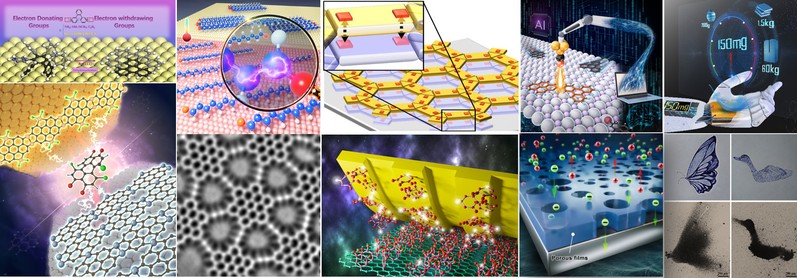
Surface and Interface Molecular Science and Technology is the cutting-edge interdisciplinary research that could advance the frontiers of chemistry, physics, material science and biology. Its research centers on the physics and chemistry of surface/interface as well as the intelligent response therein through the utilization of unique and state-of-the-art surface/interface technologies. The research directions cover on-surface chemistry, interface assembly reactions, controlled fabrication of functional materials, and intelligent sensing devices/systems. On-surface chemistry and interface assembly reactions focus on the fundamental science such as the assembly, reaction and the construction of new molecules at the atomic and molecular scales. By means of advanced tools such as atomic force microscopy (AFM) and scanning tunneling microscopy (STM) and the combination with other methodologies, we are going to reveal the surface ensembles, structures, properties of the functional materials at the atomic or molecular level, which leads to the novel intelligent matter systems. The research in controlled fabrication of functional materials and intelligent sensing devices/systems aims to achieve the on-demand intelligent matter with precision preparation and property regulation for multi-functional sensing and intelligent perception.

1. On-surface chemistry
On-surface chemistry, as an emerging synthetic method, is utilized to prepare covalently linked organic nanomaterials with structural control in atomic precision by on-surface reactions of molecular precursors. It has received extensive attention in the fields of surface science, synthetic chemistry, and surface catalysis. Based on the understanding of the reactions on single-crystal surfaces, we are devoted to exploring new types of on-surface reactions and the in-depth understanding of the surface’s role in tuning the mechanism, the progression, and the various stages of the reactions, as well as the structural modulation of the product. Special attention will be paid to the systematic characterization of the electronic structure and catalytic activity of carbon-based functional materials. With the development and refinement of surface high-resolution imaging and spectroscopic characterization techniques, it is expected to achieve the characterization of chemical processes and mechanisms in on-surface reactions at the level of high spatial (single-bond) and high energy resolution. This advancement can contribute to addressing key challenges in large-scale functional material synthesis and industrial catalysis, among other fields.
2. Interface assembly reaction
The research of supramolecular chemistry on surfaces focuses on the basic issues of supramolecular chemistry, such as the assembly of molecular aggregates through non-covalent interactions, host-guest recognition, and the construction of multilevel complex structures. The aim is not limited to the research of fundamental phenomena related to the supramolecules through structural characterization. It also targets the preparation and property modulation of two-dimensional supramolecular materials with tunable functions. The structure-property relationship of long-range ordered supramolecular organizations from microscopic to mesoscopic scales is the key aspect, which holds the promises to the further construction of structural low-temperature materials with ultrafast response for intelligent sensing and catalysis applications.
3. Controlled assembly reactions
Based on unique techniques such as interfacial self-assembly, self-limiting surface catalysis, and precise surface synthesis, functional materials with distinctive structures and properties are developed. By systematically investigating the synergistic effects among controlled synthesis methods, material properties, and structural variations, this research aims to establish correlations between structural evolution and material functionality. These efforts lay the foundation for the precise scalable fabrication and functional application of functional materials.
4. Smart sensing materials and systems
This research direction is dedicated to developing next-generation intelligent sensing technologies, with a focus on leveraging the unique properties of nanomaterials (such as high specific surface area, tunable surface chemistry, and specific responsiveness) and advanced fabrication techniques to establish an innovative system ranging from micro-scale sensitive units to macro-scale integrated systems. The research priorities include the design and controllable synthesis of high-performance nanosensitive materials, flexible/wearable device architectures, self-powered sensing technologies, and intelligent perception systems integrating artificial intelligence and big data. By achieving collaborative design and optimization of materials, devices, and systems, the goal is to advance sensing technologies toward high sensitivity, high reliability, low power consumption, and intelligence in key areas such as industrial safety, environmental monitoring, smart healthcare, and biomimetic electronic skin.
Editor: Danting Xiang